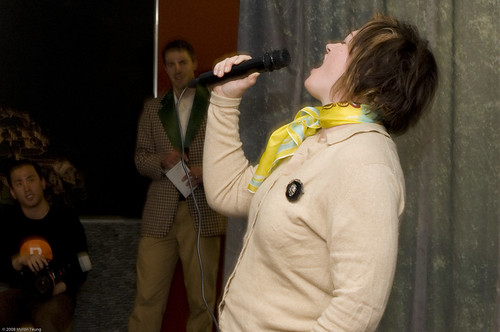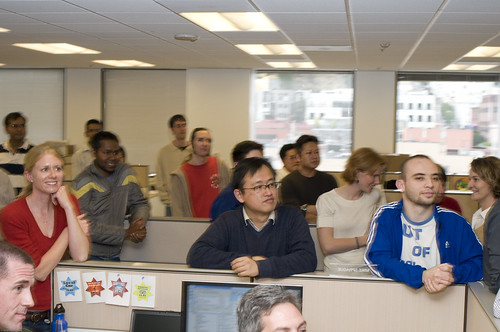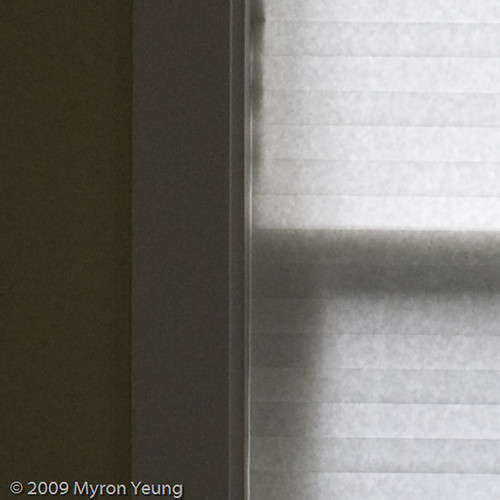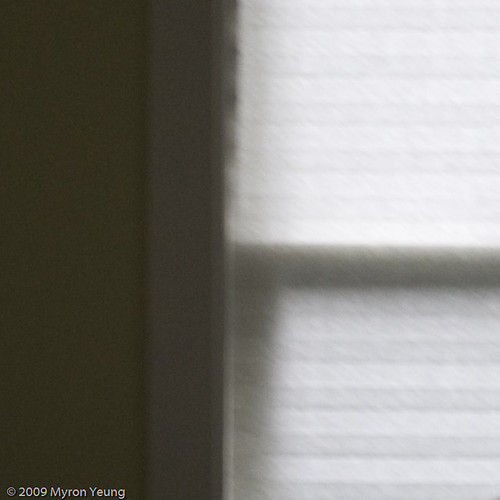Last month, my buddy Mark looked at the photos I took at my company karaoke contest and mentioned that most of them exhibited a weird flash ghosting effect.
 It's kind of hard to see, but you'll notice it if you magnify it or look at it on a large screen (look at the top of her right hand).
The culprit was camera shake. Camera shake occurs when the camera moves while the shutter is open. Your photos will appear blurry. This typically happens when a camera is handheld and the exposure time is too long. What's too long? Of course there's a handy rule of thumb...
Rule of thumb for avoiding camera shake: select an exposure time with a denominator that is larger than the effective focal length of the lens. In my case, my lens has an effective focal length of 52.5mm (35mm lens on a 1.5x cropped sensor), so any exposure time of 1/60 sec or less should be fast enough. 1/80, 1/100, or 1/250 sec and beyond are fine, but 1/40, 1/20, or 1/10 or slower will cause blur. By the way, for the rest of this post, I will use the term "shutter speed" and "exposure time" interchangeably. I prefer "exposure time", because the units are in seconds, which is a unit of time, not speed.
In the photo above, my shutter speed was 1/80 sec, which should have been fast enough to avoid camera shake according to the rule of thumb. Unfortunately I still got some blur, because my hands are naturally shaky. It also didn't help that I was squatting uncomfortably and my arm was tired.
I did a little test a few days later to see if I could induce camera shake with an exposure time of 1/50 sec. On the left, I tried to hold the camera as still as possible. As you can see, the image is not blurry. On the right, I held the camera and simulated a violent sneeze just as I squeezed the shutter release button. The image is very blurry.
Though I wasn't sneezing violently during the karaoke contest, what I proved to myself in the test above is that I need to be aware of what my hands, body, and camera are doing when my exposure time approaches the rule of thumb.
Here's how to avoid camera shake:
1. Choose a shutter speed that is fast enough for the effective focal length of your lens. In my case, just to be safe, since my hands are naturally shaky, I should choose a speed twice as fast as the inverse of my effective focal length. And/or...
2. Brace yourself and/or...
3. Brace your camera on a tripod, monopod, or a stable surface (like a desk) and/or
4. Shoot at the continuous shutter release setting, so your camera doesn't move each time you squeeze the shutter release button. Your first and last shots will be blurry, but the shots in between should be sharper.
By following one or more of these rules, not only will you avoid camera shake, but you can also shoot people at much longer exposure times which can create pleasant types of blurring. By keeping my camera still, I managed to keep his face relatively sharp, but his hands blurry:
It's kind of hard to see, but you'll notice it if you magnify it or look at it on a large screen (look at the top of her right hand).
The culprit was camera shake. Camera shake occurs when the camera moves while the shutter is open. Your photos will appear blurry. This typically happens when a camera is handheld and the exposure time is too long. What's too long? Of course there's a handy rule of thumb...
Rule of thumb for avoiding camera shake: select an exposure time with a denominator that is larger than the effective focal length of the lens. In my case, my lens has an effective focal length of 52.5mm (35mm lens on a 1.5x cropped sensor), so any exposure time of 1/60 sec or less should be fast enough. 1/80, 1/100, or 1/250 sec and beyond are fine, but 1/40, 1/20, or 1/10 or slower will cause blur. By the way, for the rest of this post, I will use the term "shutter speed" and "exposure time" interchangeably. I prefer "exposure time", because the units are in seconds, which is a unit of time, not speed.
In the photo above, my shutter speed was 1/80 sec, which should have been fast enough to avoid camera shake according to the rule of thumb. Unfortunately I still got some blur, because my hands are naturally shaky. It also didn't help that I was squatting uncomfortably and my arm was tired.
I did a little test a few days later to see if I could induce camera shake with an exposure time of 1/50 sec. On the left, I tried to hold the camera as still as possible. As you can see, the image is not blurry. On the right, I held the camera and simulated a violent sneeze just as I squeezed the shutter release button. The image is very blurry.
Though I wasn't sneezing violently during the karaoke contest, what I proved to myself in the test above is that I need to be aware of what my hands, body, and camera are doing when my exposure time approaches the rule of thumb.
Here's how to avoid camera shake:
1. Choose a shutter speed that is fast enough for the effective focal length of your lens. In my case, just to be safe, since my hands are naturally shaky, I should choose a speed twice as fast as the inverse of my effective focal length. And/or...
2. Brace yourself and/or...
3. Brace your camera on a tripod, monopod, or a stable surface (like a desk) and/or
4. Shoot at the continuous shutter release setting, so your camera doesn't move each time you squeeze the shutter release button. Your first and last shots will be blurry, but the shots in between should be sharper.
By following one or more of these rules, not only will you avoid camera shake, but you can also shoot people at much longer exposure times which can create pleasant types of blurring. By keeping my camera still, I managed to keep his face relatively sharp, but his hands blurry:
 Sometimes camera shake can produce a neat effect:
Sometimes camera shake can produce a neat effect:
 But I digress. Bottom line: camera shake is bad, so try to minimize it.
But I digress. Bottom line: camera shake is bad, so try to minimize it.
 It's kind of hard to see, but you'll notice it if you magnify it or look at it on a large screen (look at the top of her right hand).
The culprit was camera shake. Camera shake occurs when the camera moves while the shutter is open. Your photos will appear blurry. This typically happens when a camera is handheld and the exposure time is too long. What's too long? Of course there's a handy rule of thumb...
Rule of thumb for avoiding camera shake: select an exposure time with a denominator that is larger than the effective focal length of the lens. In my case, my lens has an effective focal length of 52.5mm (35mm lens on a 1.5x cropped sensor), so any exposure time of 1/60 sec or less should be fast enough. 1/80, 1/100, or 1/250 sec and beyond are fine, but 1/40, 1/20, or 1/10 or slower will cause blur. By the way, for the rest of this post, I will use the term "shutter speed" and "exposure time" interchangeably. I prefer "exposure time", because the units are in seconds, which is a unit of time, not speed.
In the photo above, my shutter speed was 1/80 sec, which should have been fast enough to avoid camera shake according to the rule of thumb. Unfortunately I still got some blur, because my hands are naturally shaky. It also didn't help that I was squatting uncomfortably and my arm was tired.
I did a little test a few days later to see if I could induce camera shake with an exposure time of 1/50 sec. On the left, I tried to hold the camera as still as possible. As you can see, the image is not blurry. On the right, I held the camera and simulated a violent sneeze just as I squeezed the shutter release button. The image is very blurry.
Though I wasn't sneezing violently during the karaoke contest, what I proved to myself in the test above is that I need to be aware of what my hands, body, and camera are doing when my exposure time approaches the rule of thumb.
Here's how to avoid camera shake:
1. Choose a shutter speed that is fast enough for the effective focal length of your lens. In my case, just to be safe, since my hands are naturally shaky, I should choose a speed twice as fast as the inverse of my effective focal length. And/or...
2. Brace yourself and/or...
3. Brace your camera on a tripod, monopod, or a stable surface (like a desk) and/or
4. Shoot at the continuous shutter release setting, so your camera doesn't move each time you squeeze the shutter release button. Your first and last shots will be blurry, but the shots in between should be sharper.
By following one or more of these rules, not only will you avoid camera shake, but you can also shoot people at much longer exposure times which can create pleasant types of blurring. By keeping my camera still, I managed to keep his face relatively sharp, but his hands blurry:
It's kind of hard to see, but you'll notice it if you magnify it or look at it on a large screen (look at the top of her right hand).
The culprit was camera shake. Camera shake occurs when the camera moves while the shutter is open. Your photos will appear blurry. This typically happens when a camera is handheld and the exposure time is too long. What's too long? Of course there's a handy rule of thumb...
Rule of thumb for avoiding camera shake: select an exposure time with a denominator that is larger than the effective focal length of the lens. In my case, my lens has an effective focal length of 52.5mm (35mm lens on a 1.5x cropped sensor), so any exposure time of 1/60 sec or less should be fast enough. 1/80, 1/100, or 1/250 sec and beyond are fine, but 1/40, 1/20, or 1/10 or slower will cause blur. By the way, for the rest of this post, I will use the term "shutter speed" and "exposure time" interchangeably. I prefer "exposure time", because the units are in seconds, which is a unit of time, not speed.
In the photo above, my shutter speed was 1/80 sec, which should have been fast enough to avoid camera shake according to the rule of thumb. Unfortunately I still got some blur, because my hands are naturally shaky. It also didn't help that I was squatting uncomfortably and my arm was tired.
I did a little test a few days later to see if I could induce camera shake with an exposure time of 1/50 sec. On the left, I tried to hold the camera as still as possible. As you can see, the image is not blurry. On the right, I held the camera and simulated a violent sneeze just as I squeezed the shutter release button. The image is very blurry.
Though I wasn't sneezing violently during the karaoke contest, what I proved to myself in the test above is that I need to be aware of what my hands, body, and camera are doing when my exposure time approaches the rule of thumb.
Here's how to avoid camera shake:
1. Choose a shutter speed that is fast enough for the effective focal length of your lens. In my case, just to be safe, since my hands are naturally shaky, I should choose a speed twice as fast as the inverse of my effective focal length. And/or...
2. Brace yourself and/or...
3. Brace your camera on a tripod, monopod, or a stable surface (like a desk) and/or
4. Shoot at the continuous shutter release setting, so your camera doesn't move each time you squeeze the shutter release button. Your first and last shots will be blurry, but the shots in between should be sharper.
By following one or more of these rules, not only will you avoid camera shake, but you can also shoot people at much longer exposure times which can create pleasant types of blurring. By keeping my camera still, I managed to keep his face relatively sharp, but his hands blurry:
 Sometimes camera shake can produce a neat effect:
Sometimes camera shake can produce a neat effect:
 But I digress. Bottom line: camera shake is bad, so try to minimize it.
But I digress. Bottom line: camera shake is bad, so try to minimize it.




No comments:
Post a Comment